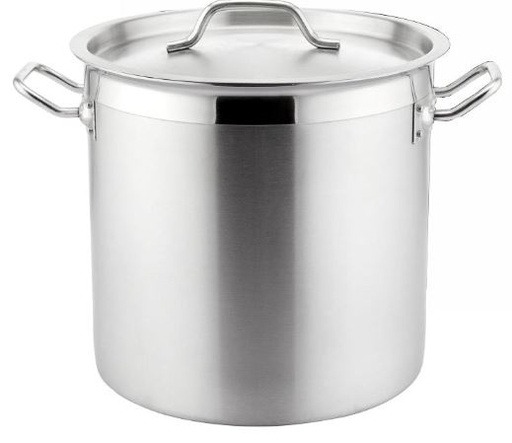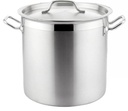Pot 12L 250X250Mm Stock Ss Sk 12525
Pot 12L 250X250Mm Stock Ss Sk
It seems you're referring to a 12L Stainless Steel Stock Pot, with dimensions 250x250mm. Here's a breakdown of the specifications:
Specifications Breakdown
1. 12L Capacity:
- The pot holds 12 liters of liquid or food, making it a medium-to-large-sized pot. This is typically suitable for preparing larger batches of food.
- A 12L pot is great for making stocks, soups, stews, or broths in a commercial kitchen or catering setting.
- It can also be used for boiling pasta, cooking large portions of vegetables, or simmering large cuts of meat for extended periods.
2. Dimensions: 250x250mm:
- 250x250mm likely refers to the width and height of the pot, meaning the pot has a square or nearly square shape. This size is relatively compact compared to larger stock pots, making it easier to store, move, and handle.
- The 250mm measurement is 25 cm (or about 9.8 inches), which indicates a medium-sized pot that could be used for various tasks in both home and commercial kitchens.
3. Stainless Steel (SS):
- The pot is made of stainless steel, a popular material for cookware due to its durability, corrosion resistance, and ease of cleaning. Stainless steel is non-reactive, meaning it won't affect the taste of acidic or alkaline foods.
- Stainless steel pots are highly resistant to rust, stains, and damage, making them long-lasting in kitchens with heavy use.
- The material also distributes heat evenly (if the pot has a good base) and is safe for cooking over high heat.
4. SK (Possible Model/Brand Identifier):
- SK could be a model number, series name, or a brand designation that indicates a specific line of cookware. It might also indicate specific features or design details (e.g., extra strong, high-quality stainless steel).
Uses of a 12L Stainless Steel Stock Pot:
Given its size and material, a 12L stock pot would be ideal for both commercial kitchens and home use. Some potential uses include:
- Making Stocks and Broths: The large capacity is perfect for making large quantities of stocks or broths, which require long simmering times.
- Soups and Stews: Ideal for cooking soups, stews, or other dishes that need to simmer for an extended period, allowing flavors to develop.
- Boiling Pasta or Vegetables: You can boil large amounts of pasta, corn on the cob, or other vegetables in a 12L pot.
- Cooking Large Cuts of Meat: It can be used to slow cook large pieces of meat, such as chicken, beef, or pork, making it suitable for stews or braising.
- Batch Cooking: Perfect for preparing large batches of food for catering, family meals, or events.
- Frying or Blanching: Although typically used for boiling or simmering, a large stock pot can also be used for deep-frying or blanching foods, such as vegetables or meats.
Advantages of a 12L Stainless Steel Stock Pot:
- Durability: Stainless steel is known for its strength and long-lasting nature. The pot will resist rust and corrosion, even under heavy use in commercial kitchens.
- Easy to Clean: Stainless steel is non-porous and relatively easy to clean. You can wash it by hand or in the dishwasher (if it is dishwasher safe).
- Non-Reactive Surface: Stainless steel won't react with acidic foods (such as tomatoes or vinegar), preserving the taste and quality of the dish.
- Even Heat Distribution: Stainless steel pots can offer good heat distribution, though they may require an aluminum or copper core in the base for faster, more uniform heating.
- Versatility: This pot can be used for various cooking methods: boiling, simmering, braising, and even frying (depending on the depth of the pot and how it’s used).
- Resistant to Staining: Unlike some other materials, stainless steel does not stain easily and maintains a clean, shiny appearance with proper care.
- Professional Look: Stainless steel gives the pot a sleek, professional appearance, which is often desired in both home kitchens and commercial settings.
Disadvantages of a Stainless Steel Stock Pot:
- Heat Retention: While stainless steel distributes heat well, it is not as effective as materials like cast iron in retaining heat. It can sometimes have hot spots if not designed with a multi-layer base.
- Weight: Larger stainless steel pots, especially with thick bases, can be heavy and may require extra effort to handle, particularly when full.
- Cost: High-quality stainless steel stock pots can be more expensive than alternatives made from aluminum or non-stick materials.
- Maintenance of Shine: Stainless steel can develop stains or marks over time, requiring regular cleaning and occasional polishing to maintain its appearance.
Care and Maintenance Tips for Stainless Steel Stock Pots:
- Clean Regularly: After each use, wash the pot with warm water and a mild dish soap. Avoid using abrasive scrubbers, which can scratch the surface.
- Polish to Maintain Shine: Stainless steel can lose its shine over time, so you might want to periodically polish the pot with a stainless steel cleaner to restore its appearance.
- Avoid Cooking Acidic Foods for Too Long: While stainless steel is generally non-reactive, cooking acidic foods for extended periods might cause some discoloration. It’s best to avoid storing acidic foods in the pot for long periods.
- Store Properly: Store the pot in a dry location to prevent water spots or corrosion. If you stack pots, place a soft cloth between them to prevent scratching.
- Heat Gradually: To ensure the pot lasts longer, heat it gradually and avoid sudden temperature changes (like placing a hot pot in cold water).
Summary:
The 12L Stainless Steel Stock Pot (250x250mm) is a medium-to-large cooking pot designed for both commercial kitchens and home cooks. Its 12-liter capacity makes it suitable for cooking large batches of soups, stocks, stews, or other slow-cooked dishes. The stainless steel construction ensures durability, easy cleaning, and resistance to corrosion, making it ideal for daily use. Its versatile design allows it to be used for various cooking methods, making it a staple in any kitchen. However, while it’s highly durable and non-reactive, it can be heavier and more expensive compared to other materials. Proper care will ensure the pot remains in top condition for many years.



